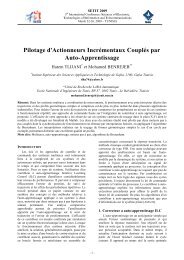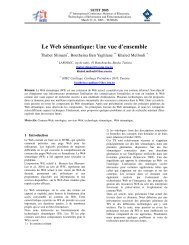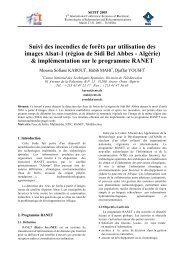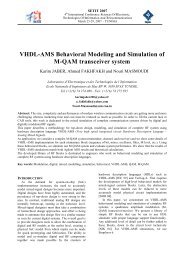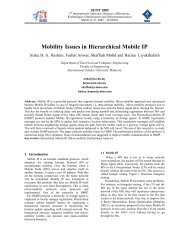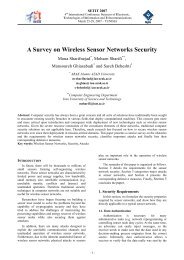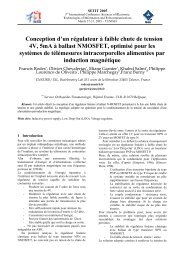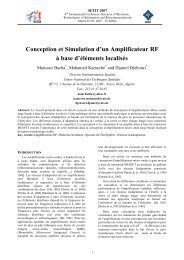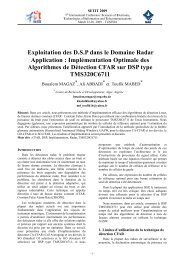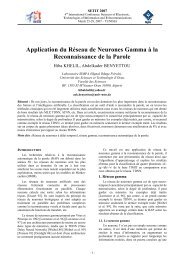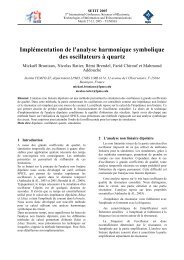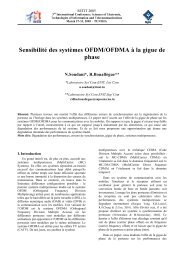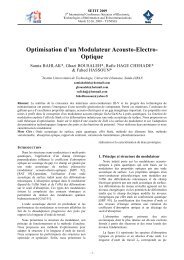Contribution of Multidimensional Trellis Coding in VDSL Systems
Contribution of Multidimensional Trellis Coding in VDSL Systems
Contribution of Multidimensional Trellis Coding in VDSL Systems
Create successful ePaper yourself
Turn your PDF publications into a flip-book with our unique Google optimized e-Paper software.
SETIT2005<br />
We will focus, now, on the case where the number<br />
Q <strong>of</strong> <strong>in</strong>formation bits transmitted per signal<strong>in</strong>g <strong>in</strong>terval<br />
is equal to 5. These five <strong>in</strong>formation bits arriv<strong>in</strong>g <strong>in</strong><br />
the current signal<strong>in</strong>g <strong>in</strong>terval n are denoted as I1n,<br />
I2n… and I5n.<br />
A 2/3 rate, 16-state code with a 4D rectangular<br />
constellation <strong>of</strong> 211 po<strong>in</strong>ts and a M<strong>in</strong>imum Square<br />
Euclidean Distance (MSED) d 2 0 is shown <strong>in</strong> Figure 5.<br />
The 4D constellation is constructed from a 48-po<strong>in</strong>t<br />
2D constellation partitioned <strong>in</strong>to eight subsets with<br />
enlarged MSED equal to 4d 2 0 , as expla<strong>in</strong>ed <strong>in</strong> (Lee-<br />
Fang Wei, 1987).<br />
I5_n+1<br />
I4_n+1<br />
I3_n+1<br />
I2_n+1<br />
I1_n+1<br />
I5_n<br />
I4_n<br />
I3_n<br />
I2_n<br />
I1_n<br />
DIFFERENTIAL<br />
ENCODING<br />
I3_n’<br />
I2_n’<br />
W2n<br />
2T<br />
W3n<br />
2T<br />
<strong>Trellis</strong> ENCODER<br />
W1n<br />
2T<br />
W4n<br />
2T<br />
I3_n’<br />
I2_n’<br />
I1_n<br />
Y0_n<br />
BIT<br />
CONVERTOR<br />
T<br />
2 T<br />
Z10_n<br />
Z9_n<br />
Z8_n<br />
Z7_n<br />
Z6_n<br />
Z5_n<br />
Z4_n<br />
Z1_n+1<br />
Z0_n+1<br />
Z1_n<br />
Z0_n<br />
Exlusive OR<br />
Signal<strong>in</strong>g Interval<br />
Delay Element<br />
Figure 5. 16-State code with 4D Rectangular constellation<br />
If we denote the current and next states <strong>of</strong> the<br />
trellis encoder as W1pW2pW3pW4p, p=n and n+2, the<br />
correspond<strong>in</strong>g 16-state trellis diagram is shown <strong>in</strong><br />
Figure 6.<br />
CURRENT<br />
NEXT<br />
STATE STATE<br />
10log<br />
2<br />
⎛ 4d0<br />
⎜<br />
⎜ 31.33d<br />
⎜ 2<br />
d0<br />
⎜<br />
2<br />
⎝ 20d0<br />
⎞<br />
⎟<br />
2<br />
0 ⎟<br />
10<br />
=<br />
⎟<br />
⎟<br />
⎠<br />
4.0713<br />
dB<br />
Where 31.33 d 2<br />
0 is the average power <strong>of</strong> the 4D<br />
constellation, and 20d 2 0 is the average power <strong>of</strong> the<br />
32QAM.<br />
2.3 Simulation Results<br />
Bit Error Rates (BER) for the two different<br />
systems have been simulated, the uncoded system (32<br />
DQAM), and the 4D 16-state code TCM system with<br />
a Viterbi decoder us<strong>in</strong>g a truncation length equal to K.<br />
In this stage <strong>of</strong> simulation, the system is simulated<br />
only with the AWGN disturbance.<br />
The results <strong>of</strong> the BER simulations, for 105<br />
<strong>in</strong>formation bits sent, are shown <strong>in</strong> Figure 7. This<br />
figure shows the BER values for different Signal-to-<br />
Noise Ratios (SNR) and for different values <strong>of</strong> the<br />
truncation length K. Both systems have the same<br />
<strong>in</strong>formation rate (5 <strong>in</strong>formation bits/symbol period).<br />
Table 2 shows that the BER decreases with K.<br />
However, the BER values become very similar for the<br />
values <strong>of</strong> K that exceed 125.<br />
BER<br />
10 −1<br />
10 −2<br />
10 −3<br />
32QAM non codée<br />
MCT:Tronc 10<br />
MCT:Tronc 40<br />
MCT:Tronc 125<br />
MCT:Tronc 500<br />
MCT:Tronc 5000<br />
MCT:No Tronc<br />
4D SUBSET<br />
0 2 1 3<br />
4 6 5 7<br />
2 0 3 1<br />
W1n W2n W3n W4n W1n+2 W2n+2 W3n+2 W4n+2<br />
0 0 0 0<br />
0<br />
0 0 0 0<br />
2<br />
0 0 0 1<br />
3<br />
1<br />
0 0 0 1<br />
0 0 1 0<br />
0 0 1 0<br />
6 4 7 5<br />
1 3 0 2<br />
0 0 1 1<br />
0 1 0 0<br />
0 0 1 1<br />
0 1 0 0<br />
10 0 SNR (dB)<br />
10 −4<br />
10 −5<br />
0 5 10 15 20 25<br />
5 7 4 6<br />
3 1 2 0<br />
7 5 6 4<br />
2 0 3 1<br />
6 4 7 5<br />
0 1 0 1<br />
0 1 1 0<br />
0 1 1 1<br />
1 0 0 0<br />
1 0 0 1<br />
0 1 0 1<br />
0 1 1 0<br />
0 1 1 1<br />
1 0 0 0<br />
1 0 0 1<br />
Figure 7. 4D TCM performance <strong>in</strong> AWGN channel<br />
As shown <strong>in</strong> Figure 7, asymptotically, the system<br />
employ<strong>in</strong>g 4D TCM code ga<strong>in</strong>s approximately 4 dB <strong>of</strong><br />
SNR over the uncoded system.<br />
0 2 1 3<br />
1 0 1 0<br />
1 0 1 0<br />
4 6 5 7<br />
3 1 2 0<br />
7 5 6 4<br />
1 3 0 2<br />
5 7 4 6<br />
1 0 1 1<br />
1 1 0 0<br />
1 1 0 1<br />
1 1 1 0<br />
1 1 1 1<br />
1 0 1 1<br />
1 1 0 0<br />
1 1 0 1<br />
1 1 1 0<br />
1 1 1 1<br />
Figure 6. <strong>Trellis</strong> Diagram <strong>of</strong> 16-State code <strong>of</strong> Figure 5<br />
The cod<strong>in</strong>g ga<strong>in</strong> <strong>of</strong> the trellis coded modulation<br />
over the uncoded 32QAM therefore is:<br />
SNR = 18<br />
K 10 20 40 125<br />
BER 0.0171 0.0096 0.0065 0.004<br />
K 500 5000 No Trunc<br />
BER 0.0051 0.0031 0.0039<br />
SNR = 19<br />
K 10 20 40 125<br />
BER 0.0054 0.0026 0.0018 5.6e-4<br />
K 500 5000 No Trunc<br />
BER 3e-4 2e-4 2.7e-4




